|
|
 |
|
Calanoida ( Order ) |
|
|
|
Clausocalanoidea ( Superfamily ) |
|
|
|
Aetideidae ( Family ) |
|
|
|
Bradyetes ( Genus ) |
|
|
| |
Bradyetes inermis Farran, 1905 (F,M) | |
| | | | | | | Ref.: | | | Farran, 1905 (p.32, Descr.F, figs.F); Rose, 1933 a (p.92, figs.F); Sewell, 1948 (p.499); Vervoort, 1952 b (n°43, p.3, figs.F); Bradford, 1969 b (p.502); Grice, 1972 a (p.224, figs.F,M, Rem.M); Markhaseva, 1996 (p.64, figs.F,M); Vives & Shmeleva, 2007 (p.549, figs.F,M, Rem.); Markhaseva & Schulz, 2006 a (p.143, 150, figs.F, Rem.) | 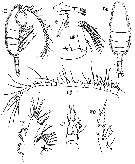 issued from : G.P. Farran in Ann. Rep. Fish. Brch., Ireland, 1902-1903, II, App. 2, 1905. [Plate III, Figs.13-20]. Female (from W Ireland): 13-14, habitus (lateral and dorsal, respectively); 15, A1; 16, A2; 17, Mx1; 18, Mxp; 19, P1; 20, P2.
|
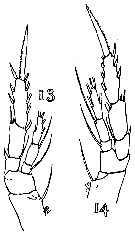 issued from : G.P. Farran in Ann. Rep. Fish. Brch., Ireland, 1902-1903, II, App. 2, 1905. [Plate IV, Figs.13-14]. Female: 13, P3; 14, P4.
|
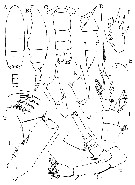 issued from : E.L. Markhaseva & K. Schulz in Invert. Zool., 2006, 3 (2). [p.145, Fig.5]. With doubt. As Bradyetes cf. inermis. Female (from S Atlantic): A-B, habitus (dorsal and lateral, respectively); C, posterior prosome and urosome (dorsal and left lateral view, respectively); E, rostrum (left lateral view); F, A2; G, Mx1 (praecoxal arthrite); H, Mxp (syncoxa); I, P1; J, P3 (exopodal segments 1 and 2); K, P4 (exopodal segments 1 and 2); L, P2. Scales: A-B 0.5 mm; remaining figures 0.1 mm. Above sea-bed at depths 4725-4469 m (41°08'S, 9°56'E) and 2889, 3005 m (60°38'S, 53°57'W and 58°16'S, 24°54'W, respectively). Nota : Mx1 : praecoxal endite with 9 long and 2 small setae (length of smaller setae varies, sometimes 1 much smaller) ; coxal endite with 4 setae (1 longer and thicker than others) ; endopod with 12 setae ; exopod with 11 setae ; coxal epipodite with 9 setae. Mx2 : praecoxal and proximal coxal endites with 3 setae each ; proximal basal endite with 3 setae (1 thicker and more sclerotized, spine-like) ; distal basal endite plus ramus with 8 setae (6 long and 2 small) ; praecoxal and coxal endites with short surface spinules. Mxp : Coxal endite with 3 setae and small sensory appendage.
|
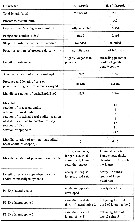 issued from : E.L. Markhaseva & K. Schulz in Invert. Zool., 2006, 3 (2). [p.150, Table I]. Female: Selected character for B. inermis Farran and the form of Markhaseva & Schulz as B. cf. inermis.
Nota: Up to now descriptions of B. inermis are not very detailed and suffer from some inconsistencies, i.e. the lateral lobe of P1 endopod is figured as being well-developed by Grice (1972), but poorly in drawings by Farran (1905).
|
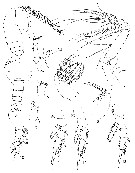 issued from : G.D. Grice in Crustaceana, 1972, 23 (3). [p.222, Figs.2-13]. Female (from off S Cap Cod): 2, habitus (lateral right side); 3, posterior end of prosome and urosome (dorsal); 4, A2; 5, Md (mandibular palp); 6, Md (cutting edge); 7, Mx2; 8, idem (other side); 9, Mxp; 10, P1; 11, P2; 12, P3; 13, P4.
|
 issued from : G.D. Grice in Crustaceana, 1972, 23 (3). [p.225, Figs.14-22]. Male (from off S Cap Cod): 14, habitus (dorsal); 15, A1; 16, Md; 17, Mx1: 18, Mx2; 19, Mxp; 20, P5; 21, idem (other side); 22, distal end of exopod of left P5. Nota: A1 with numerous setae and long aesthetasks proximally. Mouth appendages greatly reduced, no mandible blade. P5 biramous, endopods consist of one segment with the left one being more than twice the length of the right one.
| | | | | Compl. Ref.: | | | Pearson, 1906 (p.12); Grice & Hulsemann, 1965 (p.223); Vives, 1982 (p.291); Markhaseva, 1998 (p.250, Fig.4); Holmes, 2001 (p.45); Bradford-Grieve, 2004 (p.283) | | | | NZ: | 3 + 3 doubtful | | |
|
Distribution map of Bradyetes inermis by geographical zones
|
| | | | | | | Loc: | | | Morocco-Mauritania, off Madeira, off S Cape Cod, off S & W Ireland, S Atlant., Antarct. (E South Shetland Is.) | | | | N: | 8 | | | | Lg.: | | | (58) F: 2,57; (213) F: 3,2-3; M: 2,52-2,44; (968) F: 2,95; {F: 2,57-3,20; M: 2,44-2,52} | | | | Rem.: | épi-méso & bathypélagic; ? hyperbenthic.
The specimens from the South Atlantic are considered the same by Markhaseva & Schulz (2006 a) untill the type specimens can be redescribed or specimens from the type locality or specimens from the type locality in the N Atlantic have been described. | | | Last update : 08/05/2016 | |
|
|
 Any use of this site for a publication will be mentioned with the following reference : Any use of this site for a publication will be mentioned with the following reference :
Razouls C., Desreumaux N., Kouwenberg J. and de Bovée F., 2005-2024. - Biodiversity of Marine Planktonic Copepods (morphology, geographical distribution and biological data). Sorbonne University, CNRS. Available at http://copepodes.obs-banyuls.fr/en [Accessed April 25, 2024] © copyright 2005-2024 Sorbonne University, CNRS
|
|
 |
 |









